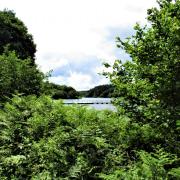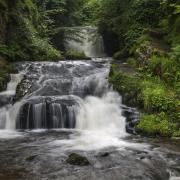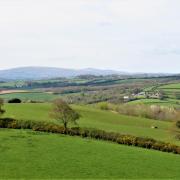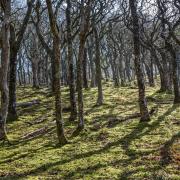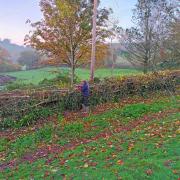Amid the students and the academics, the grounds of Exeter University are a haven for some special species of plants, as Gill Heavens reveals

Picture a university campus and what do you see? Do you envisage towers of learning, the meeting of scholarly minds in well-stocked libraries or even student revelry and high jinks? What is less likely is you imagine a registered Botanic Garden, two National Plant Collections, meadows peppered with fritillaries or an extensive sculpture trail. Undoubtedly the University of Exeter’s Streatham Campus lives up to the former classic portrayal but, incredibly, the latter list is also true.

The man in charge of this horticultural treasure trove is Director of Grounds, Iain Park, who oversees not only this 120 hectare site but also St Luke’s campus a mile away. Streatham campus is an amalgam of several large estates with Reed Hall (originally called Streatham Hall after which the campus is named) the historical hub of the horticultural campus.
The gardens were laid out in the 1860s by the renowned Veitch Nurseries and planted with many specimens collected by the equally famous plant hunters, William and Thomas Lobb and E.H. Wilson. A large foxglove tree, Paulownia tormentosa, overlooks the adjacent Italianate garden which is planted with stand-alone wisteria, under-planted with seasonal bedding, providing formality within the arboretum surroundings.
Since taking over this post in September 2007 Iain has found that compromise is a major requirement in maintaining this site as it is first and foremost a campus. Prime photography spots must be looking their best for graduation in July and both safety and security issues are paramount.
There have been major building works over the last few years, including the impressive Forum which houses a lavish new library and Student Services Centre. As anyone who has had building work will appreciate this has presented many challenges to the groundstaff. During these works a new road was diverted to avoid The Botanist Garden, which contains some rare and unusual specimens including a large Azara macrophylla. The newly positioned road was named Poole Gate in recognition of Sandy Poole; a much-loved garden foreman who worked for the University for 45 years.
Thirty-one staff are employed on site, one of whom is Laura Griffiths who, amongst other duties, tends the Azara collection. This is testament to the department’s policy to encourage young talent and has proved a worthwhile investment. Under Laura these often temperamental plants have thrived, with systematic replanting, propagating and the creation of a detailed digital herbarium. The University is also the custodian of a collection of more than 150 varieties of the increasingly popular heuchera.
Small details are not overlooked on campus, at every turn there is a well thought out gem. Outside the Business School there is a brace of scree beds – one displaying alkaline loving alpines, one for the acidic. At the entrance to the Biosciences Building there is a magnificent collection of cacti and sculptures of magnified pollen grains pop up amongst courtyard planting.
The University champions conservation and encourages both horticultural and ecological diversity; there has been some competitive bug hotel construction amongst the staff resulting in five star wildlife residences! The campus also provides a beneficial environment for humans; students, staff and visitors alike gain from these beautiful surroundings.
The grounds are diverse, with wilder wooded areas, contemporary displays of grasses, mature rhododendrons and camellias, a collection of endangered conifer, streams and lakes, a mass planting of Magnolia stellata - the list is extensive and staggering.
Iain Park’s mantra is “buildings sit in the landscape” not jarring but enhancing, and this beautiful campus, just half a mile from the centre of Exeter, proves that this can be achieved. When I asked Iain if there was any Ash Dieback on campus the answer was shockingly “yes”, he then explained with a mischievous smile that it was in a test tube in the laboratory, where scientists are attempting to find a cure for this devastating disease. I think they pretty much have it all covered.
Guided tours of the grounds are held four times a year, for more information visit the University website exeter.ac.uk or call 01392 725219. Details of the Sculpture Trial guiding you around 36 exhibits are available to download from the University website.
Azara:
There are ten species of Azara, belonging to the Saliaceae or willow family, which are native solely to South America. The RHS Plant Finder lists 20 different varieties.
They are named after the Spanish naturalist Felix de Azara who explored South America from 1781-1801. Azara lanceolata was first discovered in the Tres Montes Peninsula, Chile by Charles Darwin on his HMS Beagle voyage in December 1834 under Captain Fitzroy.
Azara are evergreen shrubs or small trees, often with attractive glossy deep green leaves. These leaves have a pronounced foliose stipule; don’t worry this just means a leaf-like growth at the base of each leaf stalk. This gives the impression of uneven leaf size.
The flowers, which are produced in the leave axils, have no petals but to make up for this shortcoming have a plethora of golden stamen. These blooms are produced, according to species, anytime from February to May. The blossom produces an unsurpassed scent of vanilla, in fact in Chile Azara microphylla is known as “aroma”.
Heuchera:
Heuchera are in the Saxifragaceae or the Saxifrage family and there are thought to be 37 members in this genus. They hybridise very easily and the RHS Plant Finder lists 412 different varieties. All species are native to North America where some were used by Native Americans for medicinal purposes, principally as a pain reliever and as a remedy against syphilis.
They were named after Johann Heinrich von Heucher who was an 18th Century German physicist. Gertrude Jekyll paired red leaved Heuchera hispida with primroses for spring display.
Heuchera are herbaceous perennials and are often grown for the colourful foliage which due to extensive breeding, especially in the USA, can be found in a rainbow of shades from amber, pinks, reds and purples to almost black.
The flowers are tiny bells which are arranged in racemes or panicles on delicate flower spikes, Heuchera sanguineum, which was introduced to this country in 1882, is sometimes called Coral Bells.
This article was first published in the March issue of Devon Life. To get the magazine delivered every month to your home, subscribe at www.subscriptionsave.co.uk/dev or call 08448484217




